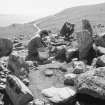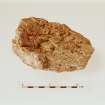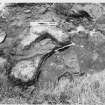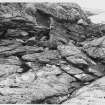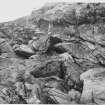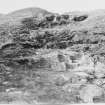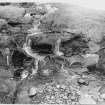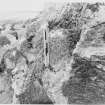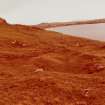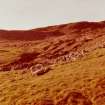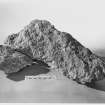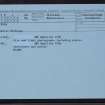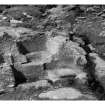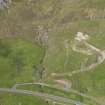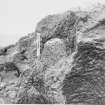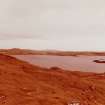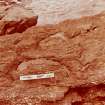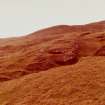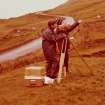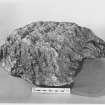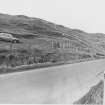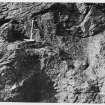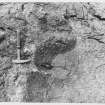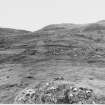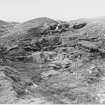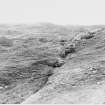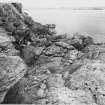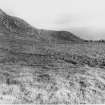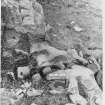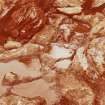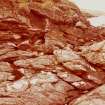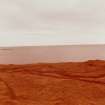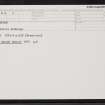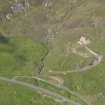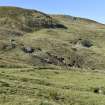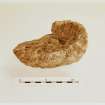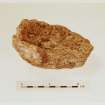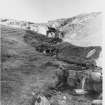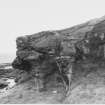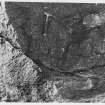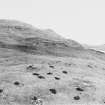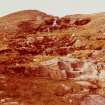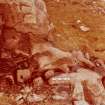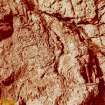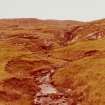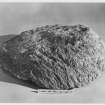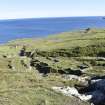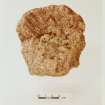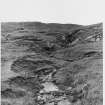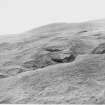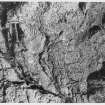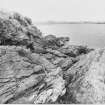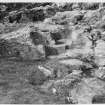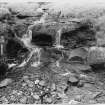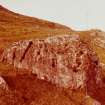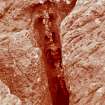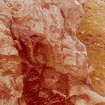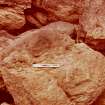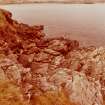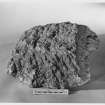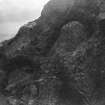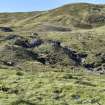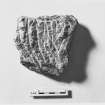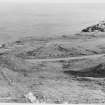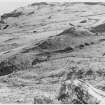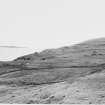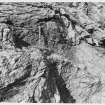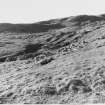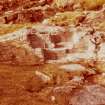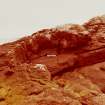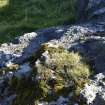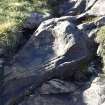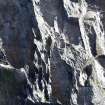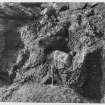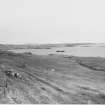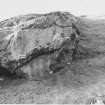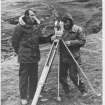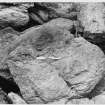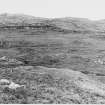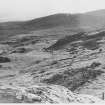Catpund
Steatite Workings (Norse), Steatite Workings (Prehistoric)
Site Name Catpund
Classification Steatite Workings (Norse), Steatite Workings (Prehistoric)
Alternative Name(s) Cunningsburgh
Canmore ID 924
Site Number HU42NW 1
NGR HU 4255 2709
Datum OSGB36 - NGR
Permalink http://canmore.org.uk/site/924
First 100 images shown. See the Collections panel (below) for a link to all digital images.
- Council Shetland Islands
- Parish Dunrossness
- Former Region Shetland Islands Area
- Former District Shetland
- Former County Shetland
HU42NW 1 4255 2709 to 4235 2705.
There are steatite workings on the right bank of the burn of Catpund.
RCAHMS 1946.
Portions of two unfinished quadrangular steatite vessels from Cunningsburgh have been presented to the National Museum of Antiquities of Scotland (NMAS).
Proc Soc Antiq Scot 1951 (donations).
Steatite workings can be seen on outcrop rock at HU 4255 2709, on the right bank of the Burn of Catpund, and higher up the burn, at HU 4235 2705. Spoil heaps from the workings can also be seen, especially at the latter site. Steatite vessels from the workings are in Lerwick Museum and the vessels from Cunningsburgh (PSAS 1951) also came from here, (Mr T Henderson, Curator, Lerwick Museum).
Visited by OS (WDJ) 8th May 1968.
HU 4232 2706 An area, 10m by 8m, was excavated through a spoil heap derived from an exposed and buried rock face. The floor of the quarry was found beneath the spoil comprising over 100 tightly packed hollows left by the removal of soapstone blocks. The size and shapes of the hollows indicate the types of vessels produced - square blocks 20cm cubed and large oval blocks c.70cm long as well as baking plates. Vessels formed from similar blocks were found in the late Norse levels (12th-13th centuries) at Jarlshof.
J R C Hamilton 1956; B Smith, S Carter and V Turner 1988.
Field Visit (1 June 1931)
Steatite Workings, Cunningsburgh. While a great many knocking-stones and bowls of sandstone have been found in Shetland, smaller vessels cut out of soap-stone or steatite also occur frequently. The manner in which they have been fashioned can be observed on the rock surfaces from which the material has been obtained. An illustration of the process is to be seen on the right bank of the burn of Catpund at Cunningsburgh (Fig. 554). Cuttings of an exactly similar character have been recorded from Rogaland in western Norway as well as from many parts of North America. Cf. Ness of Hillswick HU27NE 14.
RCAHMS 1946, visited 1 June 1931.
Publication Account (1997)
The steatite quarries cover a very large area, almost 1km long, from the shore below and to the east of the main road, rising on either side of the Catpund Burn to its headwaters in the hills to the west. As you climb up beside the burn, you will notice traces of quarrying both in the bed of the burn and on the rock outcrops on either side. Most obvious are the projecting blanks for vessels that were never removed and the round and rectangular depressions where such blanks were removed (see colour photograph on p.23 ), and the rock faces are covered with chisel marks. The method used in manufacturing steatite vessels was to carve out the rough shape of the bottom and sides of the vessel as if it were upside own on the rock, to detach this blank and to finish shaping its exterior and hollowing out the inside. The talcose rock is relatively easy to carve, being quite a soft stone that is soapy to the touch, hence its other name, soapstone, and it was used for a great number of purposes from early prehistoric times onwards. It is also known in Shetland as deber from the Norse term kieber.
Higher up the burn is an excellent area of quarrying, exposed by excavation and now fenced off with a stile for access and an information board.
Excavations at Jarlshof (no. 39), some 24km to the south, produced a variety of steatite vessels that can be matched by the blanks and discarded waste in the quarries, and steatite grit used to strengthen the clay for pottery vessels demonstrates that steatite was being exploited by the beginning of the second millennium BC. Steatite was being used most extensively in the Viking Age and early medieval times, when round, oval and square vessels were in fashion consecutively from the 9th to 13th centuries, as well as steatite line-sinkers for fishing, spindle whorls, beads and lamps (small oval dishes with a hole at either end so that they could be suspended, the wick immersed in oil). At this period the industry must have been organised on a mass market, commercial scale, with its products being exported not only all over Shetland but also to Orkney and Iceland, which lack any source of steatite.
Steatite outcrops elsewhere in Shetland as well, and there are traces of ancient quarries both on Fetlar and on Unst, particularly at Clibberswick on Unst (HP 651121) where near vertical cliff-faces were somehow worked in what must have been terrifying conditions. Steatite was also very extensively exploited in Norway itself, and work is currently underway to establish methods of petrological analysis which will allow the origin of steatite artefacts to be identified more precisely than is possible at the moment. Variety in the composition of the rock within a single deposit makes recognition of an object from one particular quarry very difficult.
Information from ‘Exploring Scotland’s Heritage: Shetland’, (1997).
Note (June 2017)
A soft metamorphic rock
During the Norse period in Scotland, outcrops of steatite were quarried at several locations on Shetland, the most extensive being those on the banks of the Catpund Burn in Cunningsburgh on South Mainland. Here steatite was removed in regular-sized blocks then shaped into vessels of a variety of forms. Such vessels have been recovered during excavations at Jarlshof some 18km to the south as the crow flies.
Steatite is a soft metamorphic rock composed mainly of mineral talc. The name is derived via Latin from the Greek for steatites, meaning precious stone. Its more common name, soapstone, gives the clue to its soft and slightly greasy texture that makes it easy to carve and readily fashion into bowls and containers. In an area where clay for pottery was relatively uncommon, steatite was highly prized, and indeed all the more so as it has excellent heat-retaining properties. In Shetland steatite is known as ‘kleber’, from the Old Norse term for ‘stone’.
Steatite workings can be seen on the rock outcrops to either side of the Catpund Burn extending eastwards from its source in the hills to the shoreline below covering a distance of almost 1km. In places, the workings are visible as round and rectangular depressions cut into the rock face from which blocks have been removed, while elsewhere they remain as projecting blocks that have been partially cut but were never fully extracted. From this, it appears that the quarrying technique was to carve out roughly the basic shape of the vessel – creating its sides and bottom as if it were upside down on the rock – before then removing the block, hollowing out the interior and smoothing off the sides. The chisel marks left by this process can still be seen on the rock faces and there are mounds of discarded waste chippings flanking the gully of the burn.
Travel and trade
Elsewhere on Shetland, other steatite outcrops have been exploited and there are traces of workings on both Fetlar and Unst. Vessels made of steatite have been recovered not only from across Shetland but also much further afield on Orkney, St Kilda and Iceland. While the local variation in the composition of the rock makes it difficult to match any one vessel with a particular quarry, the distribution of the vessels themselves suggests exportation on an organised, if not commercial, scale.
So next time you travel on the A970 between Lerwick and Sumburgh look inland up the gully of the Catpund Burn and imagine the noise of quarrymen carving out blocks of stone a thousand years ago.
References:
Foster, A K and Turner V E (eds) 2009 Kleber: Shetland’s Oldest Industry, Shetland Soapstone since Prehistory, Shetland Heritage Publica¬tions
RCAHMS 1946 Twelfth report with an inventory of the ancient monuments of Orkney and Shetland, Edinburgh, No. 1178
Ritchie, A 1997 Shetland, Exploring Scotland's Heritage series, Edinburgh, p107-9
Angela R Gannon - Archaeological Field Investigator










































































































